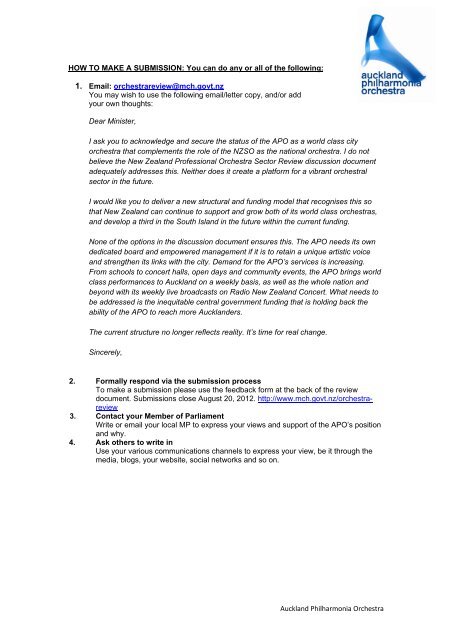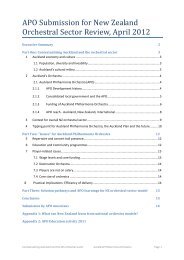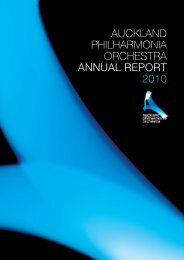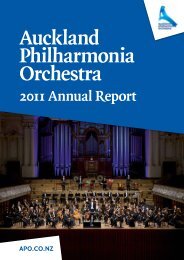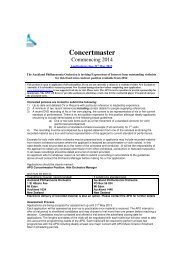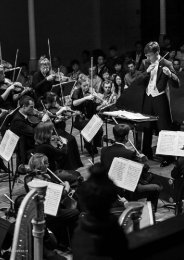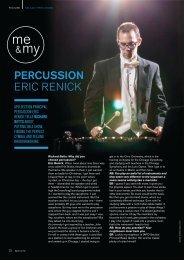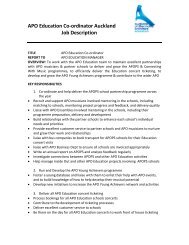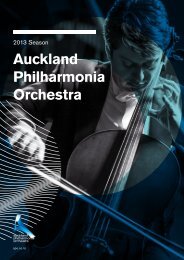HOW TO MAKE A SUBMISSION: You can do any or all of the following
HOW TO MAKE A SUBMISSION: You can do any or all of the following
HOW TO MAKE A SUBMISSION: You can do any or all of the following
Create successful ePaper yourself
Turn your PDF publications into a flip-book with our unique Google optimized e-Paper software.
<strong>HOW</strong> <strong>TO</strong> <strong>MAKE</strong> A <strong>SUBMISSION</strong>: <strong>You</strong> <strong>can</strong> <strong>do</strong> <strong>any</strong> <strong>or</strong> <strong>all</strong> <strong>of</strong> <strong>the</strong> <strong>following</strong>:<br />
1. Email: <strong>or</strong>chestrareview@mch.govt.nz<br />
<strong>You</strong> may wish to use <strong>the</strong> <strong>following</strong> email/letter copy, and/<strong>or</strong> add<br />
your own thoughts:<br />
Dear Minister,<br />
I ask you to acknowledge and secure <strong>the</strong> status <strong>of</strong> <strong>the</strong> APO as a w<strong>or</strong>ld class city<br />
<strong>or</strong>chestra that complements <strong>the</strong> role <strong>of</strong> <strong>the</strong> NZSO as <strong>the</strong> national <strong>or</strong>chestra. I <strong>do</strong> not<br />
believe <strong>the</strong> New Zealand Pr<strong>of</strong>essional Orchestra Sect<strong>or</strong> Review discussion <strong>do</strong>cument<br />
adequately addresses this. Nei<strong>the</strong>r <strong>do</strong>es it create a platf<strong>or</strong>m f<strong>or</strong> a vibrant <strong>or</strong>chestral<br />
sect<strong>or</strong> in <strong>the</strong> future.<br />
I would like you to deliver a new structural and funding model that recognises this so<br />
that New Zealand <strong>can</strong> continue to supp<strong>or</strong>t and grow both <strong>of</strong> its w<strong>or</strong>ld class <strong>or</strong>chestras,<br />
and develop a third in <strong>the</strong> South Island in <strong>the</strong> future within <strong>the</strong> current funding.<br />
None <strong>of</strong> <strong>the</strong> options in <strong>the</strong> discussion <strong>do</strong>cument ensures this. The APO needs its own<br />
dedicated board and empowered management if it is to retain a unique artistic voice<br />
and streng<strong>the</strong>n its links with <strong>the</strong> city. Demand f<strong>or</strong> <strong>the</strong> APO’s services is increasing.<br />
From schools to concert h<strong>all</strong>s, open days and community events, <strong>the</strong> APO brings w<strong>or</strong>ld<br />
class perf<strong>or</strong>mances to Auckland on a weekly basis, as well as <strong>the</strong> whole nation and<br />
beyond with its weekly live broadcasts on Radio New Zealand Concert. What needs to<br />
be addressed is <strong>the</strong> inequitable central government funding that is holding back <strong>the</strong><br />
ability <strong>of</strong> <strong>the</strong> APO to reach m<strong>or</strong>e Aucklanders.<br />
The current structure no longer reflects reality. It’s time f<strong>or</strong> real change.<br />
Sincerely,<br />
2. F<strong>or</strong>m<strong>all</strong>y respond via <strong>the</strong> submission process<br />
To make a submission please use <strong>the</strong> feedback f<strong>or</strong>m at <strong>the</strong> back <strong>of</strong> <strong>the</strong> review<br />
<strong>do</strong>cument. Submissions close August 20, 2012. http://www.mch.govt.nz/<strong>or</strong>chestrareview<br />
3. Contact your Member <strong>of</strong> Parliament<br />
Write <strong>or</strong> email your local MP to express your views and supp<strong>or</strong>t <strong>of</strong> <strong>the</strong> APO’s position<br />
and why.<br />
4. Ask o<strong>the</strong>rs to write in<br />
Use your various communications channels to express your view, be it through <strong>the</strong><br />
media, blogs, your website, social netw<strong>or</strong>ks and so on.<br />
Auckland Philharmonia Orchestra
HEADLINE ISSUES: APO’s views which you may wish to include:<br />
ISSUE ONE: The proposed scenarios <strong>do</strong> not <strong>all</strong>ow <strong>the</strong> sect<strong>or</strong> to develop<br />
• The one-plus-four (one international-standard <strong>or</strong>chestra plus regionals) model <strong>do</strong>es not<br />
reflect current reality.<br />
• New Zealand already has two w<strong>or</strong>ld class <strong>or</strong>chestras, APO and NZSO, and <strong>the</strong><br />
government needs to continue to supp<strong>or</strong>t both, while increasing supp<strong>or</strong>t f<strong>or</strong> <strong>the</strong> APO.<br />
• The proposed scenarios would constrain <strong>the</strong> role and potential growth <strong>of</strong> city and regionbased<br />
<strong>or</strong>chestras.<br />
• The Discussion Paper’s gloomy analysis <strong>of</strong> <strong>the</strong> ch<strong>all</strong>enges facing <strong>the</strong> sect<strong>or</strong> is not<br />
reflected by <strong>the</strong> APO’s experience (Please refer to attached APO fact sheet)<br />
• Constraining repertoire that <strong>the</strong> APO is “<strong>all</strong>owed” to play (as is suggested in <strong>the</strong><br />
Discussion Paper) is <strong>the</strong> fastest way to constrain our growth and standards. APO’s artistic<br />
growth has been <strong>the</strong> result <strong>of</strong> a clear vision including <strong>of</strong>fering audiences <strong>the</strong> full range <strong>of</strong><br />
symphonic experience.<br />
ISSUE TWO: Economic efficiencies and cost <strong>of</strong> <strong>or</strong>chestras<br />
• There is no analysis <strong>of</strong> current spending across <strong>the</strong> sect<strong>or</strong> within <strong>the</strong> <strong>do</strong>cument.<br />
• There is no analysis <strong>of</strong> efficiencies, if <strong>any</strong>, likely to be achieved by <strong>any</strong> <strong>of</strong> <strong>the</strong> potential<br />
restructuring scenarios.<br />
• The Discussion Paper suggests that an international standard <strong>or</strong>chestra requires $13.4m<br />
<strong>of</strong> government funding (what <strong>the</strong> NZSO currently receives annu<strong>all</strong>y) and <strong>the</strong>ref<strong>or</strong>e two are<br />
unaff<strong>or</strong>dable. APO’s success (with $2.1m c<strong>or</strong>e central funding) demonstrates that<br />
international standards <strong>can</strong> be achieved and fur<strong>the</strong>r developed f<strong>or</strong> less money.<br />
• A different business model, which <strong>all</strong>ows government funding to be distributed in a m<strong>or</strong>e<br />
economic<strong>all</strong>y beneficial way, should be considered.<br />
ISSUE THREE: What about <strong>the</strong> nuts and bolts<br />
• What is needed is a practical yet ambitious assessment that includes a th<strong>or</strong>ough<br />
economic analysis.<br />
• Some areas <strong>of</strong> NZ receive little <strong>or</strong> no access to <strong>or</strong>chestral music and education<br />
programmes. The review should consider how <strong>the</strong>se issues may be addressed.<br />
• With some good economic modeling and analysis, and sensible and strategic use and<br />
development <strong>of</strong> existing capabilities, good solutions could be developed.<br />
• There are o<strong>the</strong>r sect<strong>or</strong>s such as Health, Universities etc which have successfully<br />
addressed devolution issues.<br />
ISSUE FOUR: The options posed ign<strong>or</strong>e <strong>the</strong> demographic changes in New Zealand<br />
The <strong>do</strong>cument itself talks <strong>of</strong> <strong>the</strong> n<strong>or</strong>thward population expansion and drift, but <strong>the</strong> options <strong>do</strong><br />
not follow through.<br />
• The proposed models <strong>do</strong> not recognise recent changes and future projections.<br />
o New Zealand has changed drastic<strong>all</strong>y since 1946 when <strong>the</strong> national <strong>or</strong>chestra<br />
model was introduced. At that time, <strong>the</strong> population <strong>of</strong> New Zealand was 1.78m,<br />
and Aucklanders comprised 12.5% <strong>of</strong> that.<br />
o In 2012 Aucklanders are 34% <strong>of</strong> <strong>the</strong> population – 1.5m people.<br />
o By 2050 Auckland will have 50% <strong>of</strong> <strong>the</strong> population and a different ethnic mix from<br />
<strong>the</strong> rest <strong>of</strong> <strong>the</strong> country. The role <strong>of</strong> Auckland’s <strong>or</strong>chestra needs to reflect that.<br />
ISSUE FIVE: The role <strong>of</strong> <strong>or</strong>chestras has changed: so must <strong>the</strong> funding structure<br />
• The impact and reach <strong>of</strong> <strong>or</strong>chestras <strong>can</strong>not be solely measured by attendance on <strong>the</strong><br />
concert h<strong>all</strong> stage.<br />
• Modern <strong>or</strong>chestras have broad and deep engagement with <strong>the</strong>ir communities as<br />
evidenced by <strong>the</strong> APO’s m<strong>any</strong> Education and outreach programmes. These matter.<br />
• Modern <strong>or</strong>chestras collab<strong>or</strong>ate across <strong>the</strong> arts sect<strong>or</strong> to produce new and exciting<br />
programmes and achieve efficiencies<br />
• It is internation<strong>all</strong>y recognised that <strong>or</strong>chestras have a role in <strong>the</strong> broader arts and<br />
education sect<strong>or</strong>s, including social development <strong>of</strong> young people, but <strong>the</strong>re needs to be<br />
constant contact to effectively achieve this. It needs appropriate funding.<br />
Auckland Philharmonia Orchestra
Auckland Philharmonia Orchestra Fact sheet<br />
About <strong>the</strong> APO:<br />
Auckland Philharmonia Orchestra:<br />
• was established in 1980<br />
• is one <strong>of</strong> two full-time pr<strong>of</strong>essional symphony <strong>or</strong>chestras in New Zealand<br />
• contracts 70 full-time musicians, engaging extra players as required<br />
• employs 22 FTE admin and management staff<br />
• is a full-sized <strong>or</strong>chestra, though at <strong>the</strong> sm<strong>all</strong>er end<br />
• is Auckland’s largest perf<strong>or</strong>ming arts <strong>or</strong>ganisation<br />
• plays to well over 100,000 people each year<br />
• presents m<strong>or</strong>e than 45 <strong>of</strong> its own concerts in Auckland every year and perf<strong>or</strong>ms m<strong>any</strong><br />
m<strong>or</strong>e with and f<strong>or</strong> o<strong>the</strong>r <strong>or</strong>ganisations<br />
• is committed to excellence, engaging w<strong>or</strong>ld-class conduct<strong>or</strong>s and soloists. Top<br />
classical artists <strong>the</strong> <strong>or</strong>chestra has recently engaged include James Ehnes, Mi<strong>do</strong>ri,<br />
Michael Collins and Nikolai Demidenko .<br />
• has Australasia’s most comprehensive education, community and outreach<br />
programme, APO Connecting, which reaches m<strong>or</strong>e than 23,000 young people each<br />
year, with APO musicians making m<strong>or</strong>e than 200 school visits annu<strong>all</strong>y<br />
• broadcasts m<strong>or</strong>e live concerts nation<strong>all</strong>y and internation<strong>all</strong>y on radio and internet than<br />
<strong>any</strong> o<strong>the</strong>r New Zealand <strong>or</strong>chestra<br />
• plays regularly f<strong>or</strong> <strong>the</strong> NBR New Zealand Opera, Royal New Zealand B<strong>all</strong>et and <strong>the</strong><br />
Michael Hill International Violin Competition<br />
• plays a strong supp<strong>or</strong>t role f<strong>or</strong> o<strong>the</strong>r Auckland <strong>or</strong>chestras. APO players are involved<br />
with <strong>the</strong> o<strong>the</strong>r <strong>or</strong>chestras as teachers, players, ment<strong>or</strong>s and conduct<strong>or</strong>s<br />
• received $2.2m in funding from central government and $2.25 from Auckland<br />
ratepayers through <strong>the</strong> Auckland Regional Amenities Funding Board in 2011<br />
The APO initiates new and ongoing cross-cultural and multi-artf<strong>or</strong>m projects. These have<br />
included 2011’s Sacre: The Auckland Dance Project, which involved nearly 200 students in<br />
a pr<strong>of</strong>ession<strong>all</strong>y ch<strong>or</strong>eographed perf<strong>or</strong>mance <strong>of</strong> Stravinsky’s The Rite <strong>of</strong> Spring; and 2012’s<br />
Remix <strong>the</strong> Orchestra, where classical met hip-hop. Programmes such as <strong>the</strong>se and o<strong>the</strong>rs,<br />
have been life-changing f<strong>or</strong> <strong>the</strong> participants, m<strong>any</strong> <strong>of</strong> whom have changed <strong>the</strong>ir life<br />
aspirations as a result.<br />
In 2011 <strong>the</strong> APO partnered with <strong>the</strong> Ministry f<strong>or</strong> Culture and Heritage to establish Sistema<br />
Aotearoa, <strong>the</strong> country’s first Sistema-based social development and music education<br />
programme.<br />
In addition to <strong>the</strong>ir APO w<strong>or</strong>k, APO musicians <strong>do</strong> approximately 300 hours per week <strong>of</strong><br />
instrumental teaching, from primary to tertiary level, thus playing a key role in developing <strong>the</strong><br />
next generation <strong>of</strong> musicians.<br />
Auckland Philharmonia Orchestra
APO achievements and growth over <strong>the</strong> past five years<br />
The number <strong>of</strong> concerts <strong>the</strong> APO presents has consistently increased annu<strong>all</strong>y since 2006,<br />
with a big increases since <strong>the</strong> introduction <strong>of</strong> <strong>the</strong> Auckland Regional Amenities Funding Act.<br />
Concerts and school visits have increased, to <strong>the</strong> limits <strong>of</strong> <strong>the</strong> available funding. The total<br />
Education audience has increased from 15,193 in 2008 to m<strong>or</strong>e than 23,000 in 2011. There<br />
is m<strong>or</strong>e demand than we <strong>can</strong> satisfy.<br />
The five <strong>or</strong>chestras under review show an over<strong>all</strong> 46% revenue increase between 2000 and<br />
2010. The APO over<strong>all</strong> increase in same period was 69% – APO has grown much m<strong>or</strong>e<br />
than o<strong>the</strong>r <strong>or</strong>chestras in <strong>the</strong> period.<br />
As f<strong>or</strong> o<strong>the</strong>r <strong>or</strong>chestras, <strong>the</strong> APO percentage <strong>of</strong> government funding is increasing – due in<br />
APO’s case to supp<strong>or</strong>t from Auckland Council to develop a strong city-based <strong>or</strong>chestra. The<br />
APO’s percentage <strong>of</strong> central government funding is still less than <strong>the</strong> average f<strong>or</strong> <strong>the</strong> five<br />
<strong>or</strong>chestras, and much less than comparable international <strong>or</strong>chestras.<br />
The review <strong>do</strong>cument says that <strong>or</strong>chestra audiences are declining. That is not true f<strong>or</strong> <strong>the</strong><br />
APO. Subscriptions revenue increased from $551,757 in 2007 to $844,306 in 2011.<br />
While <strong>the</strong>re was a peak in public ticket sales in 2007 at <strong>the</strong> height <strong>of</strong> <strong>the</strong> economic boom,<br />
public sales to <strong>the</strong> APO have been stable in a time <strong>of</strong> economic restraint: 2008 – $635,664;<br />
2009 – $723,055; 2010 – $583,955; 2011 – $693,019.<br />
From 2007-2011 <strong>the</strong> APO perf<strong>or</strong>med 202 paid concerts, including low-cost concerts in sm<strong>all</strong><br />
venues. The annual average paid attendance was 21,065 people, <strong>or</strong> 1037 paid attendees<br />
per concert.<br />
Background to <strong>the</strong> current Orchestral Review:<br />
In 2011 <strong>the</strong> Ministry f<strong>or</strong> Culture and Heritage announced a review <strong>of</strong> New Zealand’s<br />
pr<strong>of</strong>essional <strong>or</strong>chestra sect<strong>or</strong>. The government’s aim was to assess whe<strong>the</strong>r <strong>the</strong> existing<br />
structure <strong>of</strong> “one national and four region<strong>all</strong>y based <strong>or</strong>chestras” represents <strong>the</strong> best delivery<br />
<strong>of</strong> <strong>or</strong>chestral services to New Zealanders.<br />
The Current Funding Model:<br />
- was established in 1946, based on <strong>the</strong> <strong>following</strong> parameters: one full-time pr<strong>of</strong>essional<br />
<strong>or</strong>chestra (now <strong>the</strong> NZSO) and several sm<strong>all</strong> amateur <strong>or</strong>chestras. There are now two fulltime<br />
pr<strong>of</strong>essional <strong>or</strong>chestras: NZSO and APO.<br />
- The NZSO is funded directly by an act <strong>of</strong> parliament. Central government funding to <strong>the</strong><br />
o<strong>the</strong>r <strong>or</strong>chestras comes indirectly through Creative New Zealand (CNZ), which receives<br />
most <strong>of</strong> its grant funding monies from Lotteries. That funding is reviewed f<strong>or</strong> each<br />
<strong>or</strong>ganisation on a regular basis.<br />
- The government’s entire <strong>all</strong>ocation f<strong>or</strong> <strong>the</strong> <strong>or</strong>chestral sect<strong>or</strong> (direct government funding<br />
plus CNZ funding) is approximately $17 million. NZSO’s p<strong>or</strong>tion is $13.4m; APO’s is approx<br />
$2.1m. This uneven <strong>all</strong>ocation reflects <strong>the</strong> 1946 situation, not current demographic and<br />
artistic realities. In 1946 NZ’s population was 1.78m, with 250,000 living in Auckland –<br />
12.5% <strong>of</strong> <strong>the</strong> national population. In 2012, 1.5 million people live in Auckland, 34% <strong>of</strong> <strong>all</strong><br />
New Zealanders.<br />
Auckland Philharmonia Orchestra
The APO’s Position on <strong>the</strong> Orchestral Review:<br />
• The APO has grown artistic<strong>all</strong>y and in actual size and is now one <strong>of</strong> two internationalclass,<br />
full-time pr<strong>of</strong>essional <strong>or</strong>chestras in New Zealand and funding should reflect this<br />
• $2 million f<strong>or</strong> <strong>the</strong> APO out <strong>of</strong> an <strong>all</strong>ocated $17 million in government funding is not<br />
appropriate f<strong>or</strong> a metropolis <strong>of</strong> Auckland’s size and an <strong>or</strong>chestra that serves its<br />
citizens/community to <strong>the</strong> degree <strong>the</strong> APO <strong>do</strong>es<br />
• The APO <strong>do</strong>es not anticipate an increase in funding f<strong>or</strong> <strong>the</strong> sect<strong>or</strong> as a whole. We<br />
accept that over<strong>all</strong> funding within <strong>the</strong> <strong>or</strong>chestral sect<strong>or</strong> <strong>can</strong>not currently be increased.<br />
However, <strong>the</strong> APO believes that <strong>the</strong> government’s contribution could be m<strong>or</strong>e equitably<br />
distributed, with a different model acknowledging <strong>the</strong> need f<strong>or</strong> a national touring<br />
<strong>or</strong>chestra, recognising <strong>the</strong> APO’s status as a w<strong>or</strong>ld-class pr<strong>of</strong>essional <strong>or</strong>chestra based<br />
in Auckland, and <strong>the</strong> potential to develop a third outstanding <strong>or</strong>chestra based in <strong>the</strong><br />
South Island,<br />
• The APO has a proud rec<strong>or</strong>d <strong>of</strong> engaging <strong>the</strong> community through APO Connecting.<br />
Current funding levels constrain our ability to meet demand.<br />
• The APO has reached <strong>the</strong> limit <strong>of</strong> what <strong>can</strong> be achieved with <strong>the</strong> funding it has, and<br />
<strong>the</strong>re is a demand f<strong>or</strong> our services that we are currently unable to meet.<br />
• Extra funding <strong>the</strong> APO received would be applied in m<strong>any</strong> areas. We would increase<br />
<strong>the</strong> range <strong>of</strong> APO Connecting (education, community and outreach) programmes we<br />
<strong>of</strong>fer, extending <strong>the</strong> <strong>or</strong>chestra’s reach, particularly to <strong>the</strong> west and n<strong>or</strong>th <strong>of</strong> Auckland; it<br />
would provide long-term stability f<strong>or</strong> <strong>the</strong> <strong>or</strong>chestra and enable it to continue to grow and<br />
develop. It would provide stability f<strong>or</strong> our players, which in turn enables <strong>the</strong> <strong>or</strong>chestra to<br />
attract and retain high quality musicians, benefitting <strong>the</strong> <strong>or</strong>chestra, audiences and<br />
community alike. And it would enable <strong>the</strong> <strong>or</strong>chestra to consistently engage <strong>the</strong> w<strong>or</strong>ld’s<br />
leading artists (soloists and conduct<strong>or</strong>s).<br />
• Recent research shows that regional cultural institutions such as <strong>the</strong> APO are among<br />
Aucklanders’ top 5 fact<strong>or</strong>s contributing to <strong>the</strong> vision <strong>of</strong> Auckland as <strong>the</strong> w<strong>or</strong>ld’s most<br />
liveable city. (source: Colmar Brunton, ‘Aucklanders and <strong>the</strong> arts: Attitudes, attendance,<br />
and participation in 2011’, 23 May 2012).<br />
• In <strong>the</strong> Long Term Plan, Auckland Council states that “<strong>the</strong> council’s vision is f<strong>or</strong> Auckland<br />
to be <strong>the</strong> w<strong>or</strong>ld’s most liveable city…. a cultur<strong>all</strong>y rich and creative Auckland.” Council<br />
also states that “Arts, and <strong>the</strong> opp<strong>or</strong>tunity to create, participate, and experience it, play<br />
an imp<strong>or</strong>tant role in Auckland.” To this end, Council provides funding to supp<strong>or</strong>t a range<br />
<strong>of</strong> regional arts <strong>or</strong>ganisations including <strong>the</strong> Auckland Philharmonia Orchestra. However,<br />
Aucklanders should also benefit from Government supp<strong>or</strong>t f<strong>or</strong> <strong>the</strong> <strong>or</strong>chestral sect<strong>or</strong> and<br />
<strong>the</strong> present imbalance, where most government supp<strong>or</strong>t is directed towards one<br />
national <strong>or</strong>chestra, is no longer fair, n<strong>or</strong> <strong>do</strong>es it meet <strong>the</strong> needs <strong>of</strong> an <strong>or</strong>chestra serving<br />
a modern urban metropolis like Auckland.<br />
Auckland Philharmonia Orchestra


